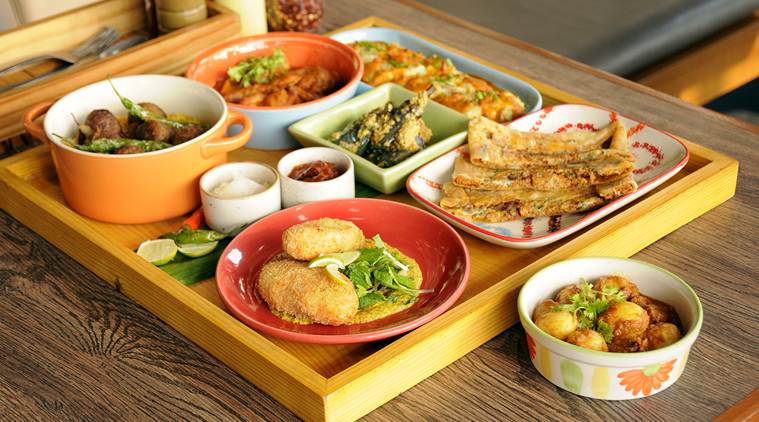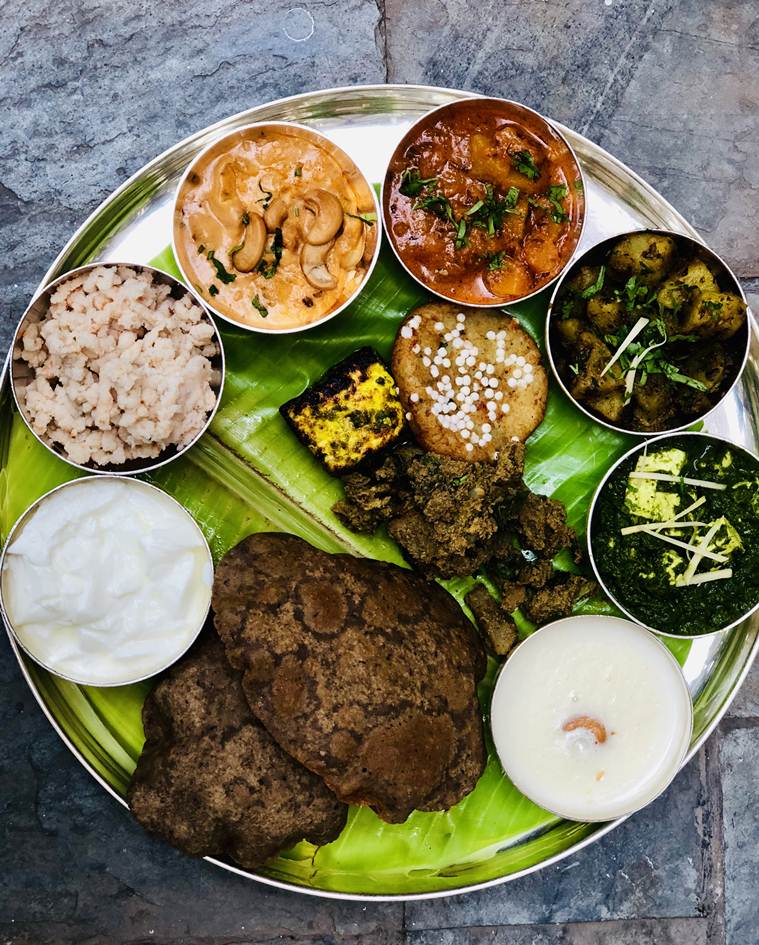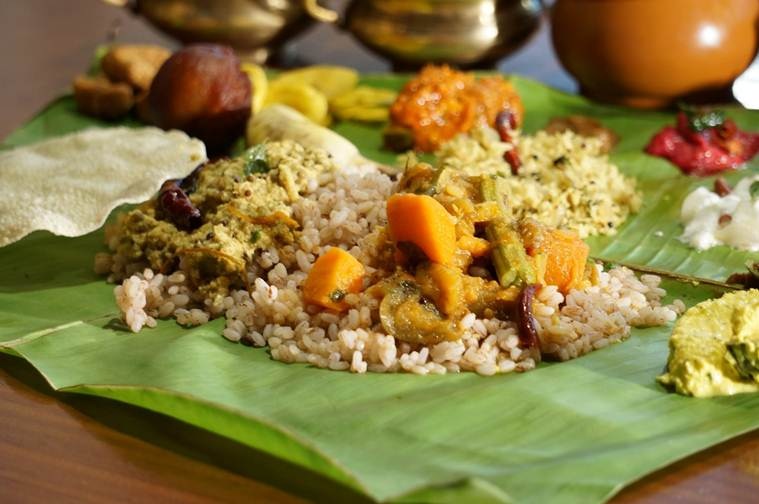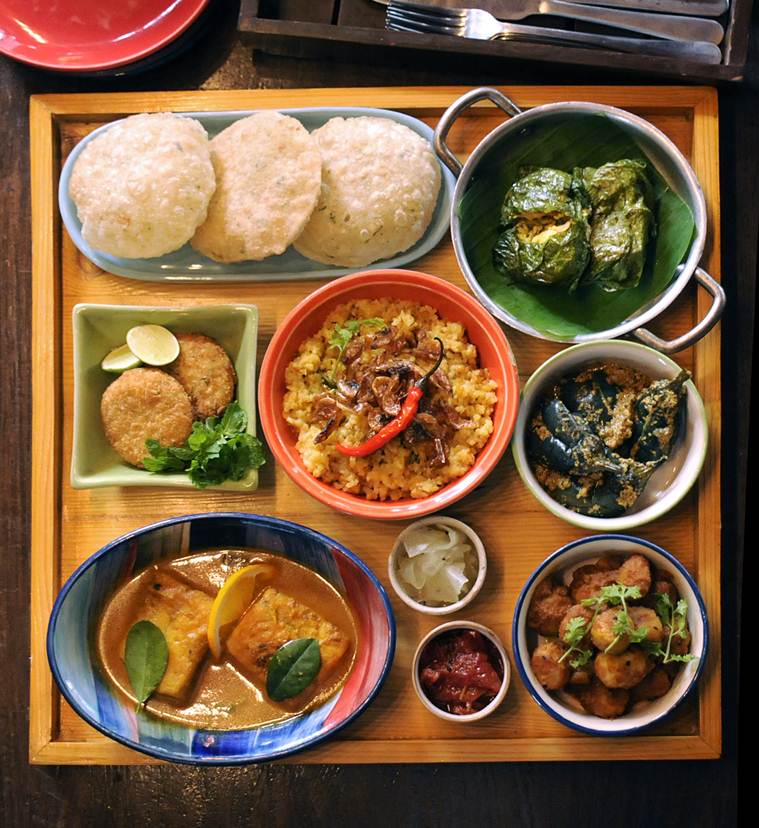 Thali derives from the word sthali, a ritual cooking pot used in the Vedic kitchen to boil rice. But the concept of the modern thali was invented by entrepreneurs from Karnataka, and the idea of limited and unlimited meals spawned.
Thali derives from the word sthali, a ritual cooking pot used in the Vedic kitchen to boil rice. But the concept of the modern thali was invented by entrepreneurs from Karnataka, and the idea of limited and unlimited meals spawned.
As the new moon waxes in the October sky, days are marked by fasts and feasts across the subcontinent’s northern belt. These dietary rhythms are reflected in the platters or thalis served during the auspicious nine-day period.
They become little microcosms of the country’s diverse culinary traditions and regional identities. From the first dash of oil that hits the pan, the spices that crackle in a tempering pot, the ingredients that fuse to create sumptuous mouthfuls and the subsequent mapping of these dishes on the thali — all allude not just to each region’s climatic subtypes and food habits but also to the similarities within our differences.
As Durga devotees dig into their favourites — maachher jhol, kosha mangsho, luchi, chholar dal, aloo posto, daab chingri, rosogulla and payesh — with greater gusto, the western and northern regions adopt a more austere approach to cooking . The story goes, says Prem K Pogakula, executive chef, The Imperial, Delhi, “When goddess Durga lived in the cave for nine days before killing the demon, she didn’t eat anything. So, we follow a restricted diet during these days. Those who fast, therefore, switch to lighter food items as a way to strengthen willpower and move closer to god.” Typically, the Navratra thali comprises simpler victuals such as jeera aloo, paneer ki bhurji, kuttu or singada ki poori, samak ke chawal, sabudana papad or khichdi, cucumber raita and sabudana or samak ki kheer.
The Bengali bhog thali, however, says Ayandrali Dutta, Delhi-based home chef and blogger, “is a simple gruel of dal and rice with a tempering of ghee and cumin seeds, and the magic ingredient of most Bengali dishes, sugar. It also includes labda, a medley of vegetables, and a tomato chutney. Even those Bengalis who don’t consume non-vegetarian during the pujo days, relish fish on Dashami.”
Thali derives from the word sthali, a ritual cooking pot used in the Vedic kitchen to boil rice. But today, “a common method of serving food is on a thali — a round metal plate about 35 cm in diameter with slightly raised edges. Once used mainly in northern India, thalis are now popular throughout the country in homes and restaurants… They can be made of silver and gold for the wealthy, bronze, kansa (an alloy of copper, tin, zinc, iron and mercury) and even styrofoam, with indentations instead of bowls for larger informal receptions,” writes Colleen Taylor Sen in Feasts and Fasts, A History of Food in India ( 2014).
Traditionally prepared during festivals and on special occasions, these elaborate platters are not the purview of north Indians alone. Kerala’s Onam, celebrated to commemorate the asura king Maveli (or Mahabali), whose rule is thought of as the golden age and whose spirit is believed to visit the state at the time of the festival, calls for the preparation of sadya — a vegetarian meal eaten for lunch. “It can include up to 26 dishes, including yam or banana chips, pachadi (pineapple in yogurt), erissery (mashed beans and pumpkin in a coconut gravy), avial, kootu curry (black chickpeas curry), rasam and sambar, with boiled rice in the centre and a banana at one side. All of this is washed down with buttermilk. Tradition has it that onion and garlic are not used in the sadya,” says Vetri Murugan, head chef at Zambar, Gurgaon. “The folding of the leaf is significant too. If it’s folded toward the guest, then it denotes a certain amount of satisfaction with the meal but the folding of the leaf away from them, means that they didn’t like the food.”
 The Navratra thali at The Imperial, Delhi.
The Navratra thali at The Imperial, Delhi.
While rice or an avatar of bread forms the nucleus of the thali, dal, pickles, chutneys and seasonal vegetable or meat preparations orbit around it to structure a consummate whole. “Cereals and lentils comprise the base. These are also larger servings on the plate. Then, following traditional knowledge and precepts of Ayurveda, vegetables are allotted a place,” says food historian Pushpesh Pant.
The dishes on the thali — which, in south India, is a banana leaf — are usually served together and eaten from left-to-right. The Bengali thali, however, presents itself course-by-course and is consumed from right-to-left. “This ensures a progression of flavours as each dish has its place in the sequence,” Dutta adds.
While it may not be fitting to suggest that the modern thali descended from the temple thaal, some of earliest records of food assembled on a platter, called naivedya, date to the 11th century. “This offering was always saatvik… at some temples, tomatoes, potatoes, red lentils, carrots and cauliflower (were not offered), perhaps because of their colour, which resembles blood, or their foreign origin. Sweets were almost always part of the offering: some temple manuals list recipes for over 200 sweet dishes. However, curdling milk with a souring agent to make chhana is not common, since it is thought to destroy the purity of the milk. The food for these offerings is usually cooked in ghee, which is considered ritually pure and auspicious,” writes Taylor Sen.
The Jagannath temple in Puri, Odisha, “served more than 100 dishes, all cooked in ghee. The gods are served ritually five times a day, and pilgrims can either eat in a large dining hall or buy prasad at a market within the temple walls,” Taylor Sen further writes. The most visited temple in India, Sri Venkateswara Temple, in Andhra Pradesh, too has gargantuan kitchens, presided over by Brahmin cooks, and is most known for its laddoos — proktham, asthanam and kalyanotsavam.
The temples of Udupi in Karnataka are famous for their food. “Their kitchens are staffed with Brahmin cooks. In the 20th century, some of these cooks opened their own restaurants serving similar vegetarian food — first locally, then all over the country and, eventually, abroad. Standard dishes on the menus of these restaurants … are sambar, rasam, idlis, dosas, vadai and coconut chutney.”
Details of Akbar’s dastarkhwan in the 16th-century Ain-i-Akbari and the accounts of European travellers mention the army of cooks — more than 400 — employed in the Mughal emperor’s court. In Ain-i-Akbari, the emperor’s food habits are distinguished in three categories. The first is of vegetarian dishes, called sufiyana, reserved for his days of abstinence, the second consisted of meat with rice or other grains and, the third, was of meat dishes such as yakhni, mussaman (mussalam), dopiazza, among others. The Catalan Jesuit priest, Antonio Monserrate, describes the feasts as, “His table is very sumptuous, generally consisting of more than 40 courses served in great dishes.
These are brought into the dining hall covered and wrapped in linen cloths, which are tied and sealed by the cook, for fear of poison. They are carried by youths to the door of the dining hall, other servants walking ahead and the master of the household following. Here, they are taken over by eunuchs, who hand them to the serving girls who wait on the royal table.”
 The sadya served by Zambar, Gurgaon.
The sadya served by Zambar, Gurgaon.
But the concept of the modern thali — set meals from different regions of India — “was invented by entrepreneurs from Karnataka, and the idea of limited and unlimited meals spawned. The commercialisation of the thali, as we know it today, started from there and others began to emulate it,” says Pant, ruing that these serve to satiate the taste of “parochial tourists and business travellers alone.” The thali, he asserts, is also symptomatic of a community’s socioeconomic status and, “of course, the ‘lower’ castes are economically deprived and socially oppressed. They aren’t allowed to use certain utensils. Their plates are mostly base metals or made of clay or leaves. Even the souring and sweetening agents in the food are indicative of a community’s status.”
So, the robust agrarian economy of Punjab finds a reflection in its thali of Amritsari kulcha, naan or makki roti, sarson saag, dal makhni, matar paneer and a tall glass of lassi. “The gravies in Punjab tend to be rich, with a base of onions, tomatoes, garlic and ginger. My mother would do a thali at home, where along with the rotis, pulao or just plain boiled rice would be served. She substituted dal makhni with a kind of dal she would make with yoghurt. I remember there would even be a bharta she would prepare on charcoal. In non-vegetarian Punjabi thalis, butter chicken takes precedence but there is also a dish of mutton that is prepared in the same vein,” says Dhruv Oberoi, who grew up in Chandigarh and is currently the head chef of Delhi’s Olive Bar and Kitchen.
In contrast, Pant points out, “the Kumaoni or Garhwali thali is based on dal and bhaat (rice) and seasonal vegetables (such as a potato fry called aloo ke gutke, a green leafy preparation known as kappa, a radish and potato mash called thechwani). Pumpkin and gourds feature as well.”
In adjoining Uttar Pradesh, from which Uttarakhand was carved out in 2000, the thali is mostly vegetarian and ends with sweets Mathura and Agra are synonymous with — peda and petha respectively. Non-vegetarian food enters UP’s culinary universe either through the cuisine of the Kayastha community or the legacy of the Awadhi court.
Like Bengalis, most dishes prepared in the Bhojpuri kitchen make use of mustard oil and a standard thali consists of “dal, bhaat and bhujia (seasonal vegetable mix). Pickles and chutneys are a big part of the thali. The oal (yam) chutney is made often in households and consumed with flax seeds in the winter. And no meal is complete without chokha,” says Pallavi Nigam Sahay, author of The Bhojpuri Kitchen (2017).
Sattu or roasted chickpea flour is the mainstay of Bihari cuisine and finds a place for itself on the thali as a paratha or the stuffing of the Bihari doughball, litti, or in a sherbet. “On Chhath a thali of thekua (sweet wheat fritters), baingan badi ki sabzi, gobhi ki sabzi are made with makhane (foxnuts) ki kheer or parwal (pointed gourd) mithai. Kohra (pumpkin) is considered auspicious and we either just sauté it or make a kohra sarson ke latpat sabzi which is pumpkin in a thick mustard gravy,” she says, adding, “our Holi thali includes non-vegetarian food but chicken is still not the preferred meat in the region. Most Biharis prefer to eat a spicy mutton curry or fish cooked in mustard.”
Among the four southern states — Kerala, Tamil Nadu, Karnataka and Andhra Pradesh — rice, lentils and legumes are staples and the spices used in the cooking — mustard and cumin seeds, asafoetida, curry leaves, fenugreek, tamarind — tend to overlap as well.
 The Pujor Special Chicken Thaala at Monkey Bar.
The Pujor Special Chicken Thaala at Monkey Bar.
While a vegetarian Tamil sappadu will consist of sambar, rasam, poriyal (sautéed vegetables), kootu (vegetable and lentils), kozhambu (tamarind flavoured broth with urad and toor dal and vegetables), poppadum, vada, and payasam, the fiery cuisine of the Chettinads, a merchant community, adds meen kulambu (fish curry) and kozhi varuval (pepper chicken) or kozhi kuruma (chicken in a coconut and almond gravy) to the regular vegetarian fare. Their spice-laden cuisine points to the community’s erstwhile reputation of being one of the biggest traders of spices in Southeast Asia.
By the same token, a vegetarian Kathiawadi thali is more than just the spicier cousin of the traditional Gujarati thali and includes khatta dhokla, sev tamatar nu shaak (sweet and spicy tomato gravy) or rigna palak nu shaak (spinach in aubergine curry), dal dhokli, Kathiawadi stuffed onion, methi thepla, kadhi, kesar shrikhand and chaas. Vaishali Tripathi, author of the Traditional Indian Thali ( 2015), notes that “most Gujarati dishes are sweet and, sometimes, jaggery is used instead of sugar and most of the food on a typical Gujarati thali comes from the state’s southern region. A new addition to this thali is of khichdi, which is now widely accepted in all regions of the state.”
The Gujarati non-vegetarian thali, often comprises the culinary gems of the Bohris, a community of Gujarati Muslim traders, which is now an integral part of the Mumbai demographic. In this version, the methi ka thepla or bajre ka chila and rice, normally flavoured with cumin seeds, can be paired with a traditional preparation of mutton in coconut milk and tamarind, along with the regular helpings of bateta nu shaak.
The Parsis, another community that docked in Gujarat, came to India during the Arab invasion in 636-651 and have their own version of the thali. The patra, says Kainaz Contractor, co-owner of Rustom’s Parsi Bhonu in Delhi, “is an elaborate affair which is exclusively reserved for eating out — either at weddings or during Navroze celebrations.” Though any Parsi dish can be served, and the Parsi wedding fare is spicier than the home-cooked meals, the list is usually limited to the classics. “It starts with gajar meva nu achaar (a sweet and spicy carrot and dried fruit pickle eaten with thin rotis and crisp fried sago chips), followed by the fish course, which includes the crowd-pleasing paatra ni macchi (pomfret coated in coriander and mint chutney and steamed in banana leaves) or saas ni macchi (fish in a sweet-and-sour white sauce that is said to have been inspired by the French béchamel sauce). My weakness for the sweet and sour flavours of Parsi food is best satisfied with the salli marghi where succulent pieces of boned chicken are cooked in tomato gravy with vinegar and sugar (or dried apricots) and garnished with a generous heap of deep-fried potato straws. My father always judges the skill of the wedding caterer by the quality of the mutton pulao dar and now I find myself doing the same. It should be delicately spiced, but the flavours must be bold enough to stand apart from the masala dal that is lavished over it. The most iconic dish is saved for last — the lagan nu custard (a baked egg custard with a bounty of nuts and raisins, cardamom and nutmeg),” she says.
How does one approach this scintillating interplay of sweet, spicy and sour flavours? Contractor says, “As most Parsi uncles do – with their hands and a massive appetite!”